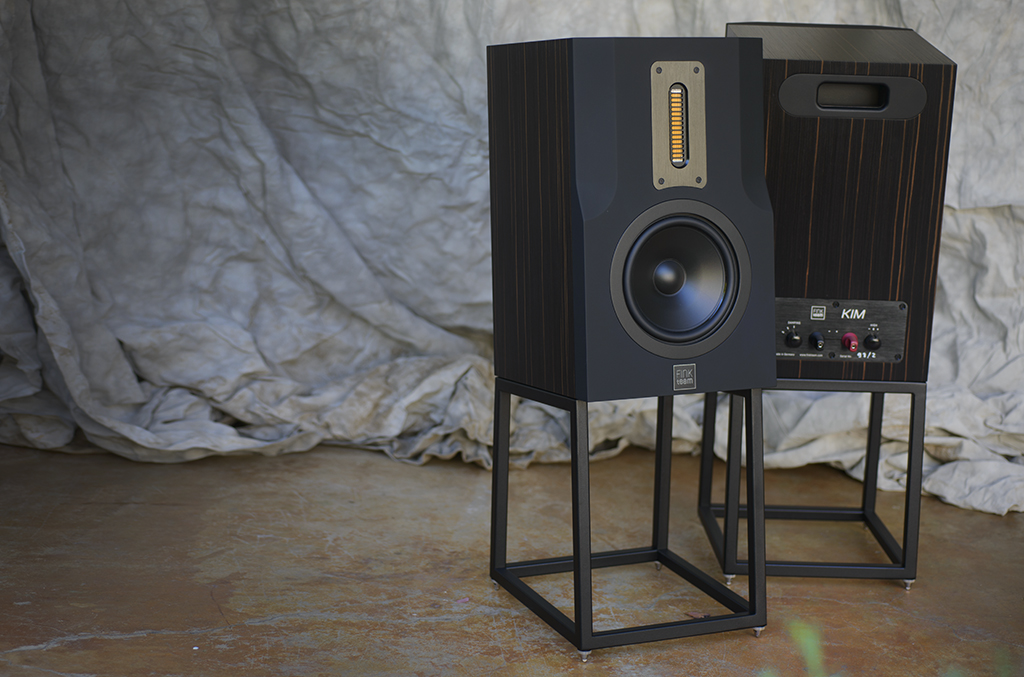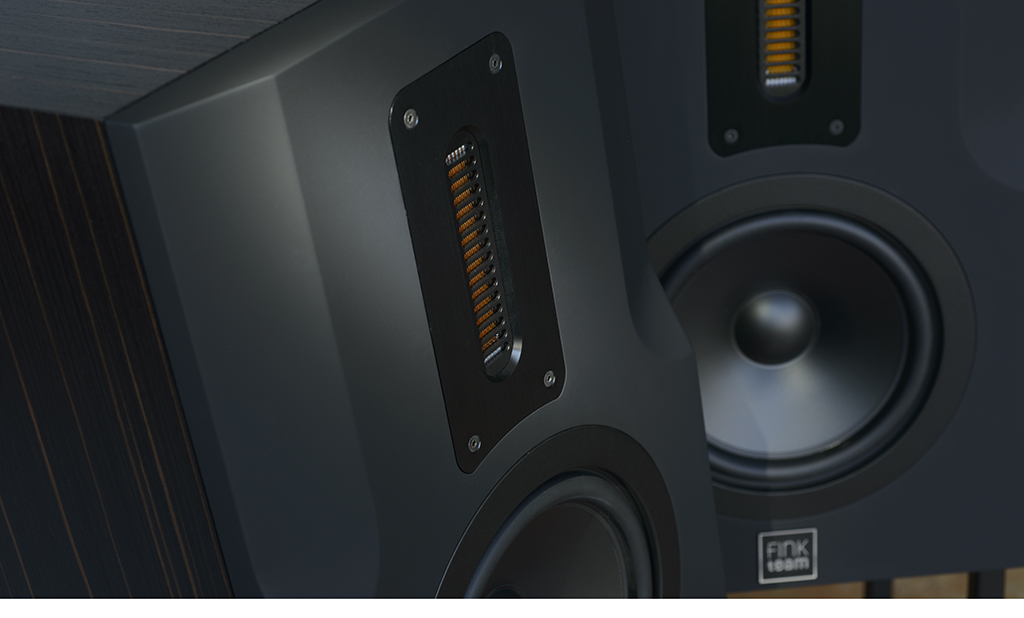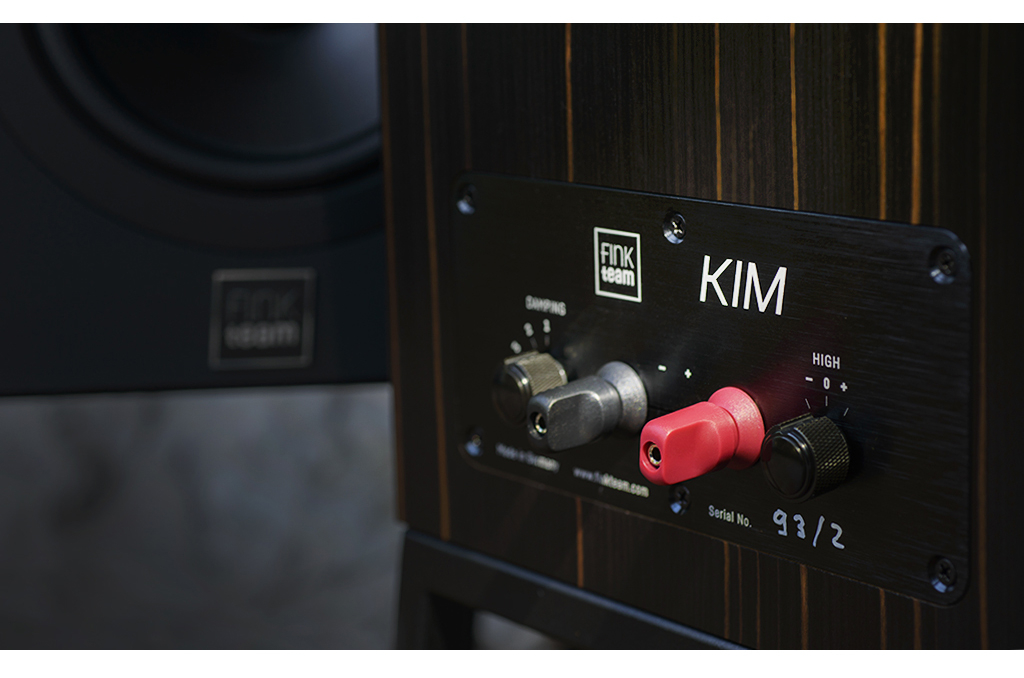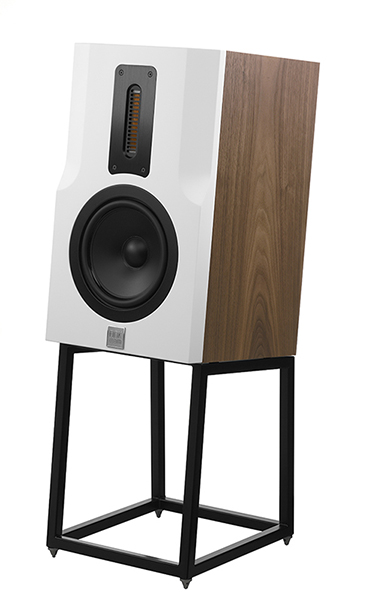REVIEW – The FinkTeam Kim Speakers Small and Special
By Jeff Dorgay With all the internet banter about speaker “break-in,” (and, yes we do believe in it) you know a speaker is special when it sounds fantastic right out of the box.
With all the internet banter about speaker “break-in,” (and, yes we do believe in it) you know a speaker is special when it sounds fantastic right out of the box.
When a speaker sounds as musical and inviting as the FinkTeam Kim speakers when you play the first track – in this case, the Rolling Stones “Has Anybody Seen my Baby?” it only gets better as the hours pile up.
Audiophile dinosaur that I am, my first experience with the Heil AMT (air motion transformer) goes all the way back to high school, when my neighbor brought home a pair of ESS AMT-1 tower speakers. Interestingly enough, this particular speaker was a 2-way design, featuring an AMT tweeter and a 10-inch woofer loaded with a transmission line. It’s interesting that these speakers follow a similar, albeit very refined concept. After listening to AR3a’s in my system, (back then) the clarity and speed from the Heil tweeter was a revelation. FinkTeam’s current implementation is a forward firing model, 110mm (4.33 inches) long, delivering great horizontal dispersion. Thanks to the integral stands, correct rake angle is close to perfect from initial unpacking. Your listening position will of course, dictate toe-in and fine adjustment of these parameters.
FinkTeam has developed their AMT with Mundorf, who also builds the driver and they’ve engineered it for a minimum of down-firing treble energy. This makes the Kims much easier to set up. The high end gets flat and muffled in a hurry when you have it wrong. Don’t panic, just dial in a little more lift to the rear of the speaker stands. And don’t be shy with the toe-in either.
These two-way speakers, complete with stands have an introductory MSRP of $11,995/pair. You can read the full specs on the FinkTeam website, but perhaps the most important is that they offer a sensitivity of 86db/1-watt, and though this might seem slightly inefficient, these speakers prove incredibly easy to drive with everything from a 25 wpc Class-A amplifier, up to my reference Parasound JC-1+ monos with over 400 watts per channel. And, they are easy to use with tube amplifiers of modest power.
Though you may not have heard of this relative newcomer, FinkTeam is a lot like Porsche Design in the sense that they have been doing a lot of engineering and design projects for a number of companies for years. Like that other famous German design house, they stay in the shadows unless said manufacturer mentions their work. “Over the past 30 years Karl-Heinz Fink and his team have collaborated with Denon, Yamaha, Mission, Tannoy, Wharfedale, Mordaunt-Short, Naim, Q Acoustics, Boston Acoustics, Castle, Marantz, IAG and Bentley, among many others.” This is why these speakers come to market so highly evolved.
Context
We’ve been listening to several relatively compact, yet high performance speakers in the 10-20 thousand dollar a pair range; the Kims are solid contenders on a number of levels. Judged strictly on build quality and physical implementation, the Kims are tip-top. While every premium brand builds their enclosures differently, no one offers a higher level of material, finish, and fine assembly. Every joint on these speakers is executed to perfection, and this level of quality is far beyond speakers at the $5k – $7k level. The front panel is equally exquisite.
Turning the spotlight to price, the Stenheim Alumine 2s that were just here, tipped the scale at close to $12k without stands, the Sonus faber Guarneri Tradition about $17k with stands, and the Acora Acoustics SRBs top the chart at $20k with stands. Wilson, Magico, Focal, and others also have offerings at this price – it’s a very popular market segment for those wanting the refinement of six-figure floor standing speakers, yet don’t have a massive environment in which to place them.
Speaking of stands, these custom designed stands, are massive enough to get the job done, yet have a minimal footprint to interfere with imaging. It’s a nice touch to take this guesswork out of the equation, as speaker height and interface are critical to achieving maximum performance. You merely take the Kims out of their packaging and place them.
If you don’t need that last 10-15Hz of deep bass response (and you can mitigate some of this with very careful placement, taking advantage of room gain) these are exciting speakers, offering a huge helping of cost no object speaker resolution. Nearly all of our listening was done in our 13 x 18-foot room, and proved very engaging. Unless we were trying to play Led Zeppelin at near concert hall levels, the last bit of dynamics and bass extension from big speakers in a big room was not missed at all.
If your experience with ribbon tweeters has been somewhat less than awesome, I’m right there with you, on the other side of that canoe. The speed and transparency that this style driver brings is nearly always intoxicating at first listen, but often becomes fatiguing after a while. Even worse, the ribbon tweeter can’t keep up with the other driver(s) and you start to notice a disconnect in musical pace. Music with a lot of high frequency information is still compelling, but other tracks with more midrange and mid-bass energy just sound off.
However, the AMT driver is somewhat different than a traditional, pleated, ribbon driver that still essentially pushes and pulls air. The AMT is more of a folded ribbon design, with more surface area that squeezes the air out between the folds. This makes for even livelier transient response, and lower distortion due to a larger surface area. Even at high volumes, these are very low distortion speakers.
Fink produces two larger speakers, all utilizing AMT tweeters, but each of a different size, optimized for the system they are used in. The driver in the Fink is large enough to dig down into the mids somewhat and mate with the 8-inch woofer at a 2200 hz crossover point. Fink claims response down to 35hz, and while we don’t measure speakers, running some test tones, confirms that the output at 35hz is indeed strong and solid.
Taking control
Two controls on the back panel make the Kims easier to use and compatible with a wider range of amplifiers. The tweeter level control has center, +, and – settings, which tip the high end up by 0.25db[tl3] , and cut by an equal amount. This proves extremely helpful, as my living room is untreated, except for some diffusion material on the wall behind the listening couch – i.e. a more typical user environment. The main listening room out in the studio is treated to be free of major reflections, yet still somewhat live sounding. That little bit of boost and cut made it easy to optimize the Kims beyond what can be achieved with toe-in and rake angle adjustments.
This adjustment also proves helpful to fine tune the Kims to your amplifier or cables. Matterhorn Audio provided a set of HiDiamond Diamond 8 speaker cables to use with the review ($2,500/pair) that are highly complementary to the Kims. We will have a more in-depth review of the Diamond 8s shortly, but these too are worthy of your consideration. We did mate the Kims with a few different speaker cables from Cardas, Nordost, and Tellurium Q – all with good result. However, the resolving power of the Kims easily reveals the difference between them. The final choice will be up to you, but this was a very enjoyable exercise.
There’s one more adjustment the Kims have to offer, and it is just as useful as the HF level. A three-position control for woofer damping makes it much easier to mate the Kims with whatever amplifier you have on hand. We’ve reviewed more than one speaker that sounds too flat with a solid-state amplifier, or wonky in the low end with a tube amplifier. The settings are optimized for solid state, high damping factor amplifiers, moderate damping factor solid state amplifiers (this setting is excellent with your favorite Class-A, lower power solid state amp, and was heaven with the Luxman 595 Anniversary amplifier) and low damping factor tube amplifiers.
Running the gamut of tube amplifiers at our disposal from McIntosh, PrimaLuna, Conrad Johnson, BAT and Line Magnetic illustrates that these speakers play well with whatever you happen to have on hand. The open, airy feeling of the Kims with a great tube amp makes for an enormous three-dimensional experience, and that damping control came in handy.
Many speakers based on traditional ribbon tweeters have such a low impedance drop at a certain frequency point, making them unsuitable for use with a tube amplifier. The Kims are rated at 8 ohms, and FinkTeamclaims they never drop below 5.6 ohms, making for an easy load indeed.
More listening
Cool as the Kims are, extended listening takes you by surprise. Just when you might think you have a handle on the sound, a familiar bit in a well-traveled track takes you to another zone. The church bells at the beginning of David Bowie’s “The Wedding,” from Black Tie White Noise was one of these moments. Oddly enough, it was a serendipitous moment, as the church down the street from our house was ringing their bell, which triggered the urge to try this track. The attack and decay captured on this recording was incredibly lifelike and similar to what I had just heard minutes before.
The AMT tweeter does a fantastic job at speed and transparency, making for an excellent recreation of spatial cues and dimension. The time worn favorite, Jeff Beck’s Live at Ronnie Scotts, reveals room boundaries easily through these speakers. Other similar recordings, such as the Rolling Stones Stripped, or any live album that happens to be recorded in a small to modest venue comes that much more alive in your room.
Should your musical taste fall to tracks that came to life in a recording studio, the results are equally enticing. Going way back to the mid 80s to Jeff Beck’s Flash, a studio concoction with Jan Hammer reveals tons of tinkly bits, and synth riffs bouncing around the room. David Byrne’s collaboration with St. Vincent “Who” is sheer pleasure to track through, with a bouncing bass line, and layered harmonies that again, really show off the resolving capabilities of the Kims.
A large, three-dimensional soundstage is a hallmark of the AMT driver, but the implementation in the Kims, and careful crossover design takes this to another level. It’s amazing how far speaker design has come, even in the last years. The integration between woofer and tweeter is so good, it almost feels like listening to a giant, full range speaker.
Yet, even after hours of listening, these speakers are not the least bit fatiguing. Much as I dread audiophile clichés, this is one of those special speakers that will reveal enough fresh musical information, that you will rediscover your music collection with them. The fine detail that they offer up will keep you up playing more music to hear what you were missing.
A personal favorite
The sonic attributes listed above happen to be my personal favorites, so it’s somewhat selfish of me to say, I absolutely love these speakers. I’ve been trying to find a pair of ESS AMT-1 Towers for over 30 years to no avail. The Kim offers that same overall type of sound, yet with infinitely more finesse. The density of thought and execution put into the Kims is incredible. There’s a crispness to these speakers build, reminding me of a side-by-side comparison between a Rolex or a Barcelona chair next to those making knockoff copies. From a distance, it’s tough to tell, but when you get up close, the attention to fine details immediately grabs you. Great as these speakers sound, they are a pleasure to experience as part of your environment. They will appeal to the audiophile and music lover as they will to the qualityphile, desiring an equal amount of visual stimulation.
Sonic signature is always such a personal thing, almost like a fingerprint. Forget about the absolute sound for a minute, your perception of how music sounds is what’s most important. If you are looking for a pair of speakers offering a massive soundstage, and a lot of music detail without crossing the line into being harsh and fatiguing, FinkTeam’s Kim should be at the top of your list. We’re definitely keeping these… #TONEAUDIOAPPROVED
www.finkteam.com (manufacturer)
www.matterhornaudio.com (Distributor)
Peripherals
Analog Source Avid Volvere SP/Lyra Atlas/Pass XS Phono
Digital Source dCS Vivaldi ONE
Preamplifier Pass XS Pre
Amplifier Pass XA200.8 monos, Pass INT-25, Octave VS110SE, PrimaLuna EVO400, McIntosh MC1502, Conrad Johnson CAV 45mkII, Line Magnetic LM805, Nagra Classic 100, Boulder 866
Cable Cardas Clear, Clear Beyond, HiDiamond Diamond8 Speaker cable





